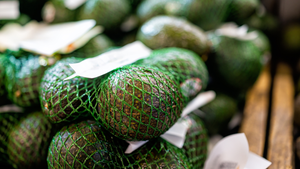The Case for Natural and Organic in NonfoodsThe Case for Natural and Organic in Nonfoods
A competitive mix sets savvy supermarkets apart.
January 1, 2018
As supermarkets continue to seek a competitive edge against Amazon, big box retailers, convenience channels and more, the natural and organic health, wellness and beauty sector presents a tremendous opportunity for differentiation. Offering variety in these categories, supported by knowledgeable staff, may be the secret of success.
“The proactive 21st century grocery store plays a key role in the decision-making of healthy shoppers, and even more so as they continue to seek natural and organic health, beauty and wellness merchandise,” says Mark Mechelse, director of research, industry insights and communications for the Global Market Development Center (GMDC) in Colorado Springs, Colo.
Today’s grocery store, says Mechelse, is at the heart of consumer welfare: “the source of everyday sustenance, self-care and homekeeping.”
Featuring insights from The Kroger Co. and natural products producer Olbas Herbal Remedies of Philadelphia, a recent GMDC report, Health & Wellness Best Practices: Why Natural and Organic Products Matter to the Health-Minded Shopper, explores the growth in herbal health supplements, as well as natural and organic health, beauty and wellness products.
The Economics of Natural
General grocery retailers can expect to see a 2.3% share point loss from 2014 to 2019 if they allow specialty retailers to maintain a firm grip on natural and organic products, warns GMDC. That loss is not insignificant in a $3.4 trillion global wellness market.
Wellness-minded stores such as Kroger are strategically placing natural and proactive products next to their conventional ones, according to customer trends and store metrics, enabling their customers to evaluate the full scope of wellness options.
Kristen Crockett, Kroger category manager of supplements, pays close attention to industry trends as she targets “highly engaged natural foods customers” when selecting her varied assortment of proactive health and wellness products.
“The more aware that shoppers become of the impacts their personal products have on their health, the more strategic their consumer habits become,” she says.
Consumers increasingly look to partnering with the grocery store for a better future. What were once considered progressive choices are now expected to be found readily and affordably alongside mainstream products, because shoppers want to know that their local supermarket supports their health-minded preferences.
“With 48 million consumers over the age of 65 (growing at 3.4% year over year) and 74% of consumers using vitamins to promote their health condition, a health and wellness mindset is not a niche anymore,” says Mechelse.
Pharmacists, Dietitians and Beauty Experts
According to recent studies by GMDC partners, shoppers trust their pharmacist’s advice more than their own family physician. In-store pharmacists who engage with customers can build long-lasting shopper loyalty.
“To further enhance that experience, retail dietitians, nutritionists and beauticians are also being trained and deployed into select markets by leading retailers,” says Mechelse. “That kind of personalization is something that online is not able to provide.”
GMDC has been working in tandem with A.T. Kearney, a Chicago-based global management consulting firm, to track consumer behavior in stores that offer natural health and wellness services. Their findings show increased expenditures and growing interest in health and wellness, even among mainstream consumers.
“This is having a profound effect on the sales of natural and organic products, as today’s consumers are savvy and will not buy products with ingredients they are not able to pronounce,” says Mechelse, who also foresees strong discretionary incomes allowing them to trade up to specialty and premium products, where mostly natural products are offered.
Grocers are uniquely positioned to save the consumer time and money as they help shoppers lead the healthier lives to which they aspire.
“As retailers recognize this, the leaders will … [design] stores around consumer health experiences at each location that identify key self-care categories that drive customers back into their stores,” he says, noting that some grocers already are doing so. “Retailers have the ability to chart interactions and support communities in ways that other providers cannot.”
Natural OTC Remedies
“Naturals are hot,” says Karen Page, national sales manager for Olbas. “Most shoppers are willing to choose a natural OTC remedy over a brand with chemical additives and ingredients they can’t pronounce. Today’s educated consumer is willing to pay more for quality, plant-sourced products.”
Olbas’ natural remedies are available in drug, mass and supermarket outlets, including Kroger. Page, who does frequent in-store demos of Olbas products, finds that shoppers respond to easy-to-digest product education in bulleted form.
In the supermarket channel, Olbas’ three best-selling products are the Olbas Inhaler, Olbas Cough Syrup and Olbas Pastilles.
The Olbas inhaler is made with essential oils, designed to provide quick, supplemental relief to the sinuses, airways and lungs. Olbas Cough Syrup is made with herbal extracts from Switzerland and pure wildflower honey to support bronchial activity. Meanwhile, sales of Olbas Pastilles, which Page says have been added to more drug and supermarkets shelves over the past few years, are thriving.
“There are few non-chemical choices in the [pastilles] category,” says Page. “Our unique gluten-free formula is especially soothing to the vocal cords.”
In terms of up-and-coming products, Page points to the Olbas Sugar-Free Lozenges, which “are gaining fast on Pastilles, as more consumers are looking to cut down on or eliminate sugar from their diets.”
The Acceleration of Natural and Organic
Many of the health problems attributed to food products are finding their narratives encroaching on the health, beauty and wellness industry as well. As a result, consumers have begun to scrutinize nonfood purchases under the same lens of health promotion and disease prevention that they use to make food and beverage selections.
“What goes on the skin goes in the body” is the general perspective of the modern, self-educated consumer. The purity of ingredients and their effects on the systems of the body (endocrine, immune, etc.) are of increasing concern.
For example, consumers with gluten sensitivity may avoid skin products containing wheat and grains. While chamomile and ginger are now used to calm skin, they were once found only in teas or digestive aids.
The shorter the list of ingredients and the easier they are to pronounce or recognize, the more likely a health-conscious consumer is to buy the product. Shoppers are gravitating toward botanicals and other natural ingredients on the packaging of their lotions, soaps, toothpastes and detergents.
“Today’s consumer is educated and motivated,” says Page. “They see themselves as a partner with their family physician, with their pharmacist and with their grocer. They see that all of those roles play a part in keeping their ship not only afloat, but on course and ahead of the storm.”
The ABCs of EDCs
Endocrine-disrupting chemicals (EDCs) are typically artificial byproducts found in the environment (e.g., streams, lakes, air, soil), food and nonfood sources, storage containers, and other conventionally manufactured products that have proven in animal studies to impair, disrupt or alter the normal functioning of the endocrine (hormone) system.
Research from the World Health Organization indicates that EDCs found in food, home and health products may be associated with health problems and chronic diseases such as arthritis, allergies, cancer and Alzheimer’s.
Two of the more common ingredients in health and home products suspected of being EDCs are phthalates and parabens. These two substances are found in plastics, soaps, lotions, perfumes and other everyday products.
Today’s consumers read labels and demand transparency. They are aware of potential dangers to their health and are arming themselves with tools to make healthful choices when they shop, browsing the aisles with a list of ingredients in one hand and Google in the other.
About the Author
You May Also Like






